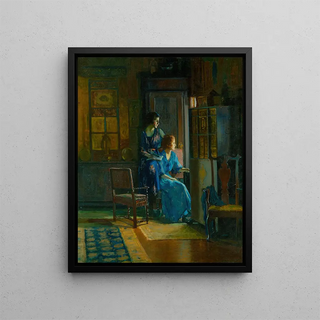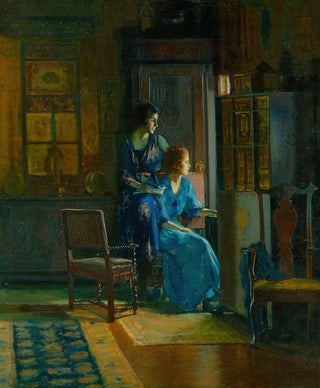Art print | At the window - Francis Coates Jones


View from behind

Frame (optional)
Francis Coates Jones's artwork "À la fenêtre" is set at a pivotal moment in American art history, where light and domestic intimacy converge in a delicate harmony. This painting, capturing a serene interior scene, invites viewers to a silent contemplation. The composition evokes a dreamlike atmosphere, where the interplay of shadows and light blends with gentle colors, offering a glimpse into everyday life at the end of the 19th century. Exploring this piece reveals not only a visual masterpiece but also an open window into the soul of its era.
Style and uniqueness of the artwork
Through "À la fenêtre," Francis Coates Jones demonstrates remarkable mastery of chiaroscuro, a technique that gives his painting emotional depth. The nuances of light filtering through the window create a striking contrast with the shadows enveloping the female figure, emphasizing her isolation and reflection. The woman, absorbed in her thoughts, becomes a symbol of melancholy and introspection, reinforced by the softness of the pastel tones used. The meticulous attention to textures, from the drapes of the dress to the details of the furniture, reflects his concern for realism and his desire to capture the fleeting beauty of the moment. This painting transcends a simple portrait to become a true psychological study, where each element contributes to the visual narrative.
The artist and his influence
Francis Coates Jones, born in 1857, was influenced by the artistic movements of his time, notably realism and impressionism. Trained at the Pennsylvania Academy of the Fine Arts, he mastered the techniques of his predecessors while developing a personal style unique to him. His interest in scenes of daily life and portraits of women demonstrates a particular sensitivity towards the female world and its nuances. Jones was also an active member of the artistic community, participating in numerous exhibitions and contributing to the evolution of American art. His work continues to inspire many contemporary artists, who see in him a pioneer in the representation of human emotions.

Matte finish

View from behind

Frame (optional)
Francis Coates Jones's artwork "À la fenêtre" is set at a pivotal moment in American art history, where light and domestic intimacy converge in a delicate harmony. This painting, capturing a serene interior scene, invites viewers to a silent contemplation. The composition evokes a dreamlike atmosphere, where the interplay of shadows and light blends with gentle colors, offering a glimpse into everyday life at the end of the 19th century. Exploring this piece reveals not only a visual masterpiece but also an open window into the soul of its era.
Style and uniqueness of the artwork
Through "À la fenêtre," Francis Coates Jones demonstrates remarkable mastery of chiaroscuro, a technique that gives his painting emotional depth. The nuances of light filtering through the window create a striking contrast with the shadows enveloping the female figure, emphasizing her isolation and reflection. The woman, absorbed in her thoughts, becomes a symbol of melancholy and introspection, reinforced by the softness of the pastel tones used. The meticulous attention to textures, from the drapes of the dress to the details of the furniture, reflects his concern for realism and his desire to capture the fleeting beauty of the moment. This painting transcends a simple portrait to become a true psychological study, where each element contributes to the visual narrative.
The artist and his influence
Francis Coates Jones, born in 1857, was influenced by the artistic movements of his time, notably realism and impressionism. Trained at the Pennsylvania Academy of the Fine Arts, he mastered the techniques of his predecessors while developing a personal style unique to him. His interest in scenes of daily life and portraits of women demonstrates a particular sensitivity towards the female world and its nuances. Jones was also an active member of the artistic community, participating in numerous exhibitions and contributing to the evolution of American art. His work continues to inspire many contemporary artists, who see in him a pioneer in the representation of human emotions.






